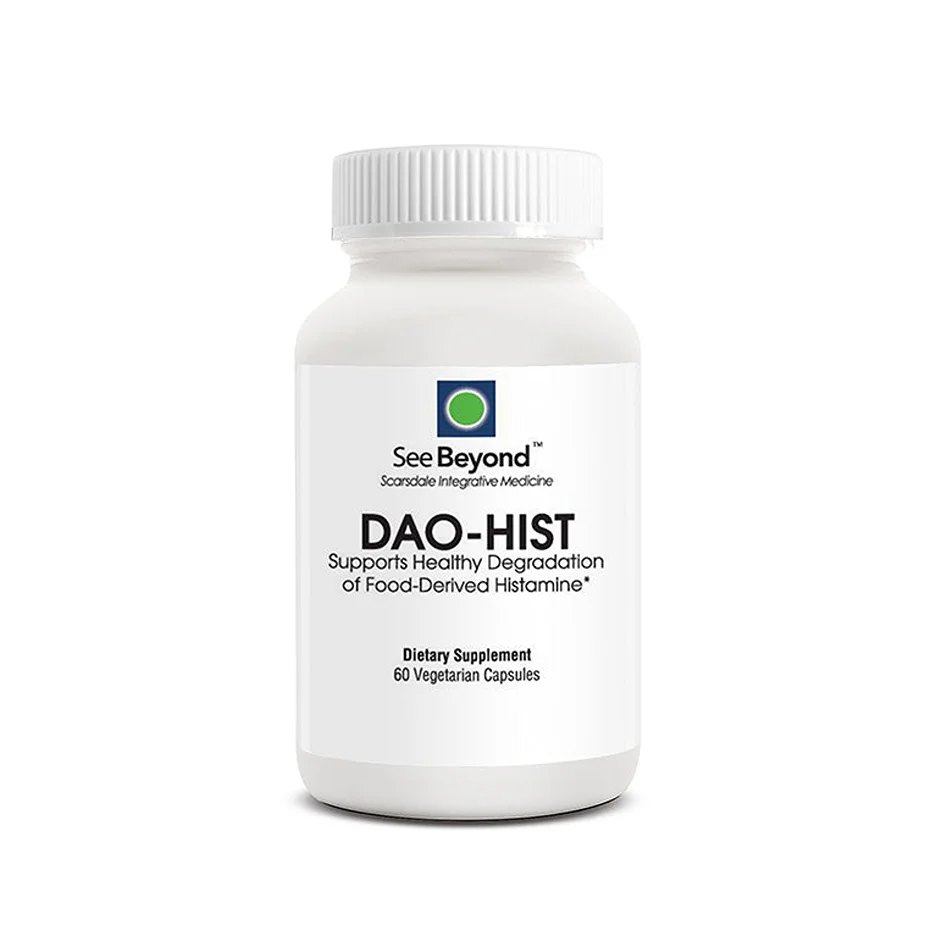The Critical Role of Manganese as a Cofactor for DAO in Regulating Histamine Levels and Metabolism
Diamine oxidase (DAO) is a key enzyme that breaks down excess histamine in the body. As histamine levels must be tightly regulated for health, DAO plays a critical role in conditions involving disturbed histamine metabolism like migraines and digestive issues.
While DAO has long been known to degrade dietary and mast cell-derived histamine, its metabolic activity relies upon an essential cofactor – manganese. New research shows manganese activates DAO, allowing it to continuously neutralize histamine.
This article explores the interdependence between DAO and manganese, and its implications for histamine-related health and disease.
Understanding Diamine Oxidases
DAO is a peroxisomal enzyme found primarily in the intestinal mucosa and placenta in humans. It acts on a variety of biogenic amines through the oxidation of amino groups. DAO utilizes its cofactor manganese to metabolize excess histamine in these tissues.
Early studies helped characterize human DAO, finding high activity levels in the intestinal mucosa with lower levels in serum and pregnant plasma. More recently, the gene and protein structures of human DAO have been identified, advancing understanding of its metabolic functions.
Levels of Diamine Oxidase in the Body and Factors Affecting It
DAO levels vary significantly between tissues and can be impacted by factors like:
- Genetics: For some individuals, genetic mutations may result in an inherent DAO enzyme deficiency. There is evidence that DAO activity levels are partly determined by hereditary factors.
- Medications: Both prescription and over-the-counter medications have the potential to indirectly lower DAO levels through various mechanisms. Common culprits include proton pump inhibitors, H2 blockers, and antidepressants which can influence histamine breakdown.
- Menstrual cycle: Studies show DAO activity fluctuates across the phases of the menstrual cycle in premenopausal women. Generally, activity is higher mid-cycle during the luteal phase compared to the early follicular phase. Hormonal changes may impact DAO levels on a monthly basis.
- Diet: Certain fermented, cured, aged or smoked foods contain higher amounts of naturally-occurring histamine that must be broken down. Without sufficient DAO, histamine intake from foods like cheese, wine and pickled vegetables can exceed the body’s degradative capacity. This contributes to a histamine load challenging for some individuals.
Intestinal Diamine Oxidase vs. Placental Diamine Oxidase
Intestinal DAO is found within enterocytes of the small intestine epithelium, positioning it optimally to break down ingested histamine before it enters circulation. Studies show intestinal DAO displays high substrate specificity for histamine over other amines due to its role in immediate dietary histamine degradation.
In contrast, placental DAO is located within syncytiotrophoblast cells lining the maternal-fetal interface. Its precise role is still under investigation. Some hypotheses propose placental DAO may regulate passage of histamine from mother to fetus, protecting the developing baby from excess levels. It may also modulate local immune responses at this sensitive site via histamine metabolism.
While both intestinal and placental DAO utilize manganese as a cofactor, some evidence suggests their molecular structures may differ slightly. Intestinal DAO appears more specialized for rapid histamine clearance from the lumen. Placental DAO could serve broader functions in histamine signaling and immunological conditions between maternal and fetal blood. Further research is needed to better distinguish their properties and importance.
Sources and Activities of Diamine Oxidase
Diamine oxidase has several natural sources in both animal and plant tissues.
| Source | Description |
| Kidneys | DAO is naturally produced in the kidneys of humans and other animals like pigs. |
| Vegetal Sources | Legume seedlings undergoing germination (“etiolation”) contain large amounts of DAO. |
| Foods | Certain foods that can increase DAO levels include kidney beans, fatty fish, cage-free eggs, and grass-fed meats. |
| Supplements | Dietary supplements containing DAO are available and may provide extra DAO activity for those with low endogenous levels or impaired kidney function. |
Pig Kidney Diamine Oxidase (DAO)
Pig kidneys are a rich source of DAO, making them invaluable in both research and therapeutic settings. The extraction of DAO from pig kidneys has facilitated the understanding of histamine metabolism and has been used as a basis for dietary supplements designed to boost DAO levels in those with deficiencies.
Comparison: Porcine Kidney vs. Oxidase in Pig Kidney
While the terms “porcine kidney” and “oxidase in pig kidney” might sound closely related, they refer to different things. The former pertains to the organ itself, while the latter zooms in on the specific enzyme (DAO) present within the pig kidney. This oxidase, with manganese as its cofactor, is pivotal in breaking down histamine.
Human Pregnancy Plasma and its Significance

During pregnancy, the balance of various biochemicals is paramount for the health of both mother and fetus. DAO levels in pregnancy plasma rise, predominantly due to the placental production. This rise ensures that histamine, which could potentially cause harm to the fetus or instigate uterine contractions, is kept in check.
Effects of Different Activities on Pregnancy
Activities such as diet, exercise, stress, and even external environmental factors can influence DAO levels during pregnancy. Any disturbance in DAO balance might lead to excessive histamine, potentially increasing the risk of pregnancy complications.
Plasma Diamine Oxidase Activity: Factors and Impacts
Various factors can impact plasma DAO levels, including genetic predispositions, dietary habits, and the presence of certain medical conditions. Elevated or depressed DAO activity might indicate issues with histamine metabolism, signaling potential risks for conditions like histamine intolerance.
Enzyme Activities and their Relevance
Enzymes, including DAO, are the catalysts of the human body, ensuring that metabolic processes occur promptly and efficiently. The activity rate of these enzymes determines the pace of these processes, making regular monitoring and understanding of these rates crucial in health and disease contexts.
Diamine Oxidase Concentrations in Various Conditions
Conditions like gastrointestinal diseases, allergies, or even certain hormonal imbalances can influence DAO concentrations.
For instance, a compromised gut lining might lead to reduced DAO production, thereby hindering histamine degradation.
Role of Substrates: Substrate Specificity and Substrate Inhibition
Like a lock requiring the right key, enzymes often have specific substrates they act upon. DAO’s primary substrate is histamine, and its efficiency is optimized for this molecule.
However, in the presence of an overwhelming amount of substrate or a molecule resembling its substrate, DAO’s activity can be inhibited, leading to reduced histamine breakdown.
Effects of Various Conditions on Plasma Postheparin Diamine Oxidase Activity
Heparin, when introduced into the bloodstream, can lead to the release of DAO into plasma. However, the DAO activity post-heparin can be affected by factors like liver health, nutritional status, and even the overall inflammatory state of the body. Monitoring this activity can provide insights into the body’s ability to regulate histamine under various conditions.
By understanding these intricate details of DAO and its interplay with histamine and other factors, we can better appreciate the delicate biochemical dance that keeps our bodies functioning optimally.
Manganese as a Cofactor
Imagine manganese as the skilled dance partner that DAO needs to glide seamlessly across the dance floor of our body’s biochemistry. Without this partner, DAO would be left standing still, unable to perform its vital function. Let’s break this down:
- Role in DAO Activation: Manganese acts as an activator for DAO, essentially turning on the enzyme and allowing it to break down histamine efficiently. Manganese binds to DAO, enabling the enzyme to achieve its active conformation and effectively metabolize histamine.
- Manganese Deficiency: Insufficient levels of manganese in the body can lead to reduced DAO activity, which may result in an accumulation of histamine. This scenario can trigger a cascade of symptoms associated with histamine intolerance.
Plasma Histaminase Activity and its significance
Histaminase is another name for DAO, especially when found in plasma. When you think about its activity in plasma, imagine a vigilant security guard patrolling a party, ensuring uninvited guests (excess histamine) don’t crash it.
- Measurement Methods: Horseradish Peroxidase and Monoclonal Antibodies: The modern medical toolkit for measuring histaminase activity employs techniques like the use of horseradish peroxidase and monoclonal antibodies. These tools help in quantifying the enzyme’s activity, much like using a thermometer to gauge the temperature.
- Effects of Oral Provocation and Doses of Heparin on measurements: Oral provocations can sometimes be used to challenge the body’s histamine metabolism and observe the subsequent DAO response. Heparin, on the other hand, can modulate DAO activity and influence its measurements. Think of this as adjusting the settings on a thermostat to see how your heater reacts.
Diamine Oxidase Supplementation

Just as we might take vitamin C to boost our immune systems, some might consider DAO supplements to bolster histamine breakdown. Let’s unwrap this:
- Benefits, usage, and considerations: DAO supplements, often derived from natural sources like pig kidneys, can provide an external source of the enzyme for those with deficiencies. But, like adding extra security guards at a bustling event, it’s essential to ensure they work in harmony with the body’s systems.
- Reduction of Histamine: Supplementation effectively boosts the body’s capacity to process excess histamine, potentially alleviating histamine-related symptoms.
Histamine in the Context of Disease and Intolerance
Histamine: it’s a double-edged sword. While essential for various bodily functions, an overload can wreak havoc.
- Histamine Intolerance: Imagine your body as a bucket. A little histamine trickles in without issues, but once it overflows – symptoms erupt. From migraines to digestive disturbances, the overflow of histamine can be felt throughout the body.
- Histamine in Diseases: Conditions like Ischaemic Bowel Syndrome have been associated with histamine, painting a picture of its wide-reaching effects. It’s like understanding the ripple effects when a stone is thrown into a pond.
Miscellaneous Connections and Considerations
- Biogenic Amines and their importance: These are a group of naturally occurring compounds that play pivotal roles in our physiology, much like different instruments in an orchestra. From mood regulation to blood pressure control, they’re instrumental in maintaining our body’s harmony.
- Specific substances and their roles: Delving into substances like Sodium Phosphate Buffer and Sodium Caseinate is like exploring the essential ingredients in a complex recipe. Each has a unique role in various biochemical reactions, contributing to the body’s intricate dance of life.
